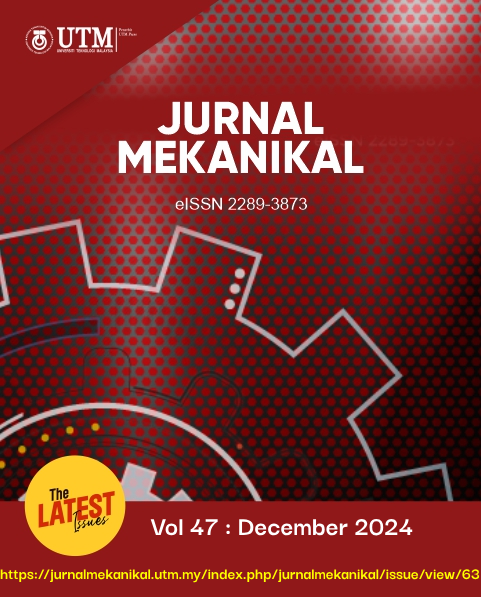CFD ANALYSIS ON DART PAPERPLANE
DOI:
https://doi.org/10.11113/jm.v47.550Keywords:
Dart paper plane model, Aerodynamic performances, micro air vehicle, CFD simulation.Abstract
This research aims to analyze the aerodynamic performances surrounding paper planes. The dart paper plane model was chosen for this work based on the availability of experimental work done by previous researchers. The dart paper plane can be categorized as one of the micro air vehicles (MAV), however, the basic aerodynamic performances have been underestimated by previous researchers and are still open to be explored. In this work, a CFD simulation study on the dart paper plane was utilized by using the ANSYS-CFX module platform. A steady state, incompressible flow Navier-Stokes equation (RANS) combined with the Shear Stress Turbulence (SST) model was used to analyze the flow structure over the dart paper planes. Experimental data availability is used to compare experimental and our simulation results. Based on the validation work, the highest average percentage difference between CLmagnitude, CLmax, and AOAstall between our results and the experimental ones is 11.9%, 29.5%, and 24.2%. However, overall CL trends similarly exhibited with experimental results since the average percentage difference of CLincre magnitude is continuously reduced from 6.48% to 0.9% towards increment of AOA. For drag performance analysis, the overall trend magnitude distribution of our simulation and experimental results consistently increases towards the increment of AOA. The massive CD distribution had overcome the consecutive CL generation, thus decreasing the overall CL/CDmax magnitude.
References
Choi, K. H. (2016). Practice-led origami-inspired fashion design: out of the frame: flight by paper plane. International Journal of Fashion Design, Technology and Education, 9(3), 210-221. doi: 10.1080/17543266.2016.1158872.
Pounds, P. (2012). Paper plane: Towards disposable low-cost folded cellulose-substrate UAVs. In Australasian Conference on Robotics and Automation (pp. 3-5).
Ng, B. F., Kng, Q. M., Pey, Y. Y., & Schluter, J. (2009, June). On the aerodynamics of paper airplanes. In 27th AIAA applied aerodynamics conference (p. 3958). doi: 10.2514/6.2009-3958.
N. I. Ismail, M. K. Khadzali, R. J. Talib, and Z. M. Ali, (2016). The Lift and Drag Performance of Paper Planes, in Mechanical Engineering Colloquium (MEC 2016), pp. 22–27.
Mueller, T. J. (Ed.). (2001). Fixed and flapping wing aerodynamics for micro air vehicle applications. American Institute of Aeronautics and Astronautics, pp. 1–10. doi: 10.2514/4.866654.
Gurnani, S., & Damodaran, M. (2019). Computational aeromechanics of paper airplanes. Journal of Aircraft, 56(5), 2070-2079. doi: 10.2514/1.C035339.
Ismail, N. I., Sharudin, H., Talib, R. J., Hassan, A. A., & Yusoff, H. (2018, May). The Influence of Hoop Diameter on Aerodynamic Performance of O-Ring Paper Plane. In IOP Conference Series: Materials Science and Engineering (Vol. 370, No. 1, p. 012034). IOP Publishing. doi: 10.1088/1757-899X/370/1/012034.
Schlueter, J. U. (2014). Aerodynamic study of the dart paper airplane for micro air vehicle application. Proceedings of the Institution of Mechanical Engineers, Part G: Journal of Aerospace Engineering, 228(4), 567-576. doi: 10.1177/0954410013476778.
Chang, M., Feng, X., Zhang, Y., Zhang, X., & Bai, J. (2023). Flow analysis on the ventral gap of a paper airplane. Proceedings of the Institution of Mechanical Engineers, Part C: Journal of Mechanical Engineering Science, 237(18), 4131-4140. doi: 10.1177/0954406220946076.
Ismail, N. I., Zulkifli, A. H., Basri, M. H., Talib, R. J., & Yusoff, H. (2015). Lift performance of a twist morphing MAV wing. Jurnal Teknologi, 75(8). doi: 10.11113/jt.v75.5206.
N. Cook, (2017), Experimental analysis of paper plane flight characteristics (Master’s thesis), University of Queensland.
Collins, J. M. (2013). The new world champion paper airplane book: Featuring the world record-breaking design, with tear-out planes to fold and fly. Ten Speed Press.
Gabriel, E. T., & Mueller, T. J. (2004). Low-aspect-ratio wing aerodynamics at low Reynolds number. AIAA J, 42(5), 865-873. doi: 10.2514/1.439.
Cosyn, P., & Vierendeels, J. (2006). Numerical investigation of low-aspect-ratio wings at low Reynolds numbers. Journal of Aircraft, 43(3), 713-722. doi: 10.2514/1.16991
Harbig, R. R., Sheridan, J., & Thompson, M. C. (2013). Reynolds number and aspect ratio effects on the leading-edge vortex for rotating insect wing planforms. Journal of Fluid Mechanics, 717, 166-192. doi: 10.1017/jfm.2012.565.
Ng, B. F., Kng, Q. M., Pey, Y. Y., & Schluter, J. (2009, June). On the aerodynamics of paper airplanes. In 27th AIAA applied aerodynamics conference (p. 3958).
Zhang, Y., Zhang, X., & Chen, G. (2021). The aerodynamic optimisation of a low-Reynolds paper plane with adjoint method. The Aeronautical Journal, 125(1285), 510-524. doi:10.1017/aer.2020.78
Sibilski, K., Nowakowski, M., Rykaczewski, D., Szczepaniak, P., Żyluk, A., Sibilska-Mroziewicz, A., ... & Wróblewski, W. (2020). Identification of fixed-wing micro aerial vehicle aerodynamic derivatives from dynamic water tunnel tests. Aerospace, 7(8), 116. doi:10.3390/aerospace7080116
Kumar, O. (2022). Aerodynamics Performance Of Fixed Wing Micro Air Vehicle With Different Planforms.
Rajanna, M. R., Johnson, E. L., Codoni, D., Korobenko, A., Bazilevs, Y., Liu, N., ... & Hsu, M. C. (2022). Finite element methodology for modeling aircraft aerodynamics: development, simulation, and validation. Computational Mechanics, 70(3), 549-563. doi.org/10.1007/s00466-022-02178-7
Ismail, N. I., Ali, Z. M., Ishak, I. S., Noor, R. M., & Rabilah, R. (2021). Aerodynamic performances of paper planes. Journal of Advanced Research in Fluid Mechanics and Thermal Sciences, 77(1), 124-131. doi.org/10.37934/arfmts.77.1.124131
Liu, D., Song, B., Yang, W., Yang, X., Xue, D., & Lang, X. (2021). A brief review on aerodynamic performance of wingtip slots and research prospect. Journal of Bionic Engineering, 18, 1255-1279. doi.org/10.1007/s42235-021-00116-6
Cook, N. (2017). Experimental analysis of paper plane flight characteristics.
Ma, P. (2024). Experimental Study and Analysis of Aerodynamic Characteristics of Gliders with Different Wing Geometries. Highlights in Science, Engineering and Technology, 93, 76-81. doi.org/10.54097/3mv6ge22
Downloads
Published
How to Cite
Issue
Section
License
Copyright of articles that appear in Jurnal Mekanikal belongs exclusively to Penerbit Universiti Teknologi Malaysia (Penerbit UTM Press). This copyright covers the rights to reproduce the article, including reprints, electronic reproductions or any other reproductions of similar nature.


















